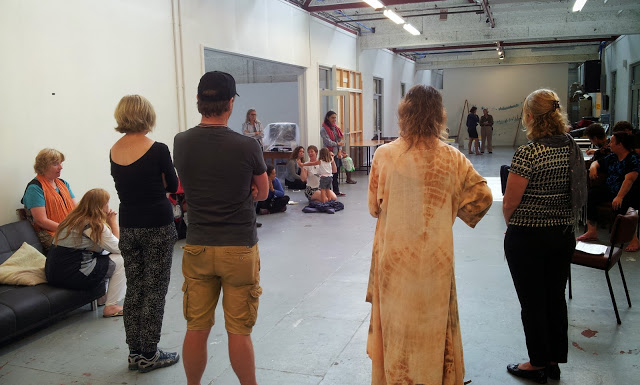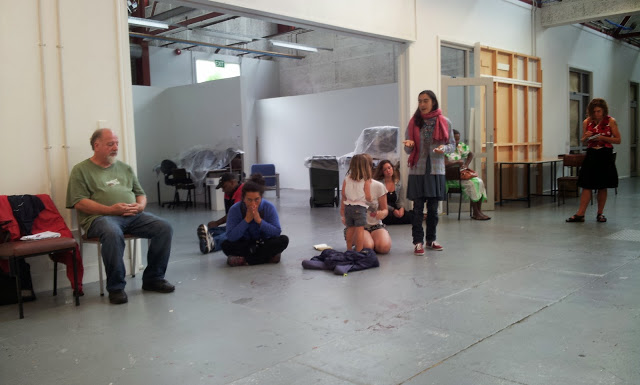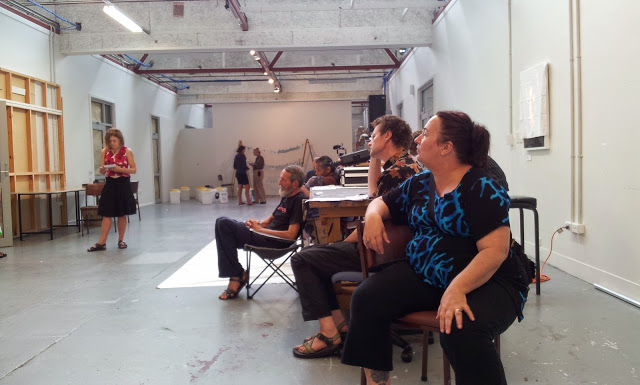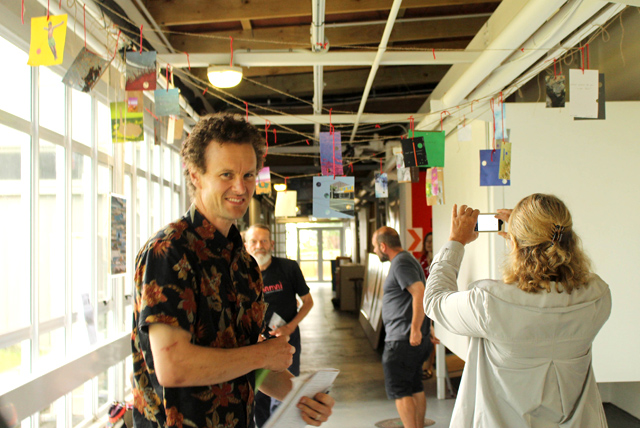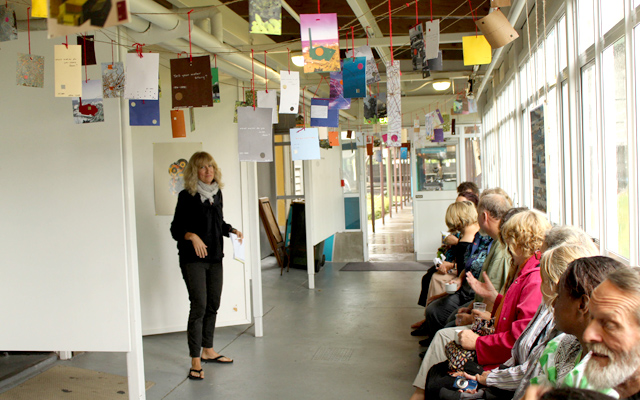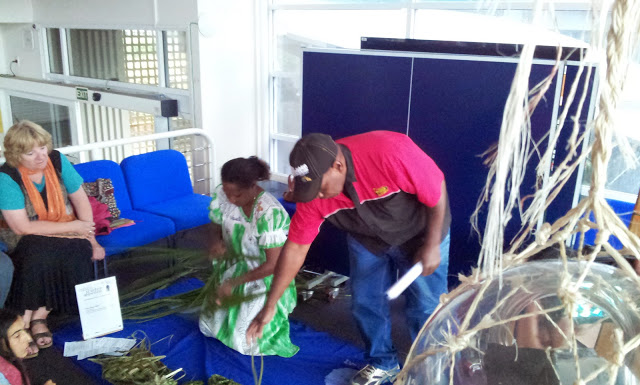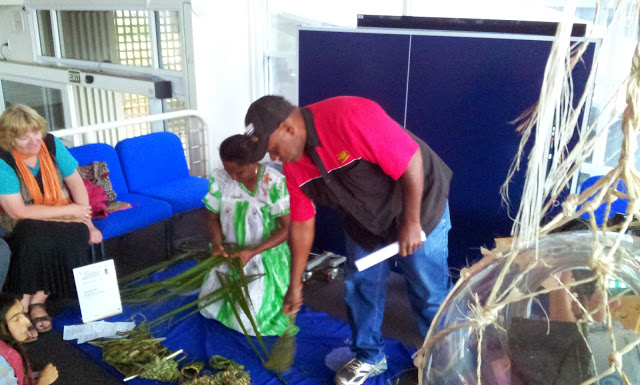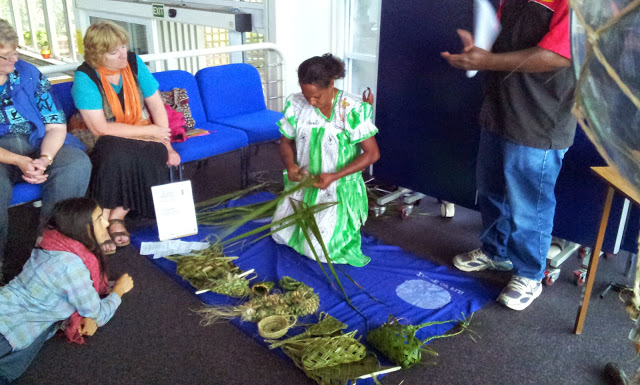Water*Peace Hui-Symposium
About the Walking Symposium
Every SCANZ has had a hui or symposium, but none have been the same. The first hui was an AGM of Aotearoa Digital Artists held on cushions on the WITT campus, adjacent to N2 the residency space then used; the second was a more formal event in the Govett-Brewster Art Gallery auditorium; the third was a hui on Waitara marae with noho marae, an overnight stay; and the fourth was in the informal spaces of WITT, on the mezzanine of the cafeteria with multiple monitors and abundant sunshine.
To facilitate the engagement with the environment it was decided that for the fifth SCANZ symposium, we would detach from electronic presentation and instead present in the environment itself. This involved traversing the Hautoki stream walkway from the sea, through the urban space of Huatoki Plaza and then into the hybrid bush of the walkway. This would mean the path of the symposium was woven into the installation of works by the residents, and that meant the creative projects could provide a context for additional presentations by those travelling to New Plymouth for SCANZ 2015.
As it happened on the day – February 2nd 2015 (mid summer) – the event was rained out but fortunately Symposium Chair Nina Czegledy had made full plans for this eventuality and we moved the symposium indoors to the WITT campus and followed the planned order of presentations.
Following are abstracts of presentations submitted by presenters – these are the presentations that were woven into the artist talks.
Wai Kōrero – An intersection of Māori Worldviews and Somatic Movement Practices in a Participatory Performance Context by Rachel Ruckstuhl-Mann
This paper describes a performance practice arising out of a Masters Degree at AUT exploring the intersection of contemporary performance and somatic practices, and Māori relational practices of powhiri and mihimihi. Through this ongoing conversation between worlds and practices, a performance mode has developed that provides a possible model for the negotation of both personal and social experiences of body, geography and memory, where all of these constructs are in question and up for transformation.
Charles Koroneho once said that powhiri are liminal spaces, thresholds between insides and outsides, ritual spaces that acknowledge what has been, what is, and allow for the opening of conversations to come. The same can be said of performance and somatic dance practices, where there is a chance to come into a different relation to your world through the proposition of what is, and what could be physically and emotionally felt through speculation (spectatorship), and/or participation. Water is both connecting and separating, but again is a liminal substance of change and transition, movement and potential.
Due to its universality, water invites participation from all walks of life and allows for the deep engagement of stories both familiar and strange. In this research and ongoing practice, water acted as a vehicle for the activation of these liminal spaces of possible experience and movement. Stories of water were collected from friends, acquaintances and strangers (some from a performance background, some not at all), and filtered through lenses of somatic body practices including Body Mind Centering, Yoga and contemporary dance. These were choreographed into sequences that explored the commonalities and differences between stories, waters and bodies. Using powhiri and whaikōrero structures the work invited and continues to invite audiences to participate and to negotiate stories, waters, bodies and performance in ways they feel comfortable with.
Both studio and site specific performances have been explored through the research, and the politics of each geography and context is tested and questioned afresh with every encounter. Each performance aims to activate the potential for the experience of a self in relation to an/other, and the possibility of recognition, release and transformation of geography, body and memory.
As an ongoing performance practice, these conversations between waters, bodies, stories and practices could be seen as a method of engaging people in a process that allows for a coming into relation to an unknown, through a connection to a deep knowing of themselves. Spaces of possible conflict, of vulnerability and of boundary pushing behaviour are gently approached with an ethos and spirit of openness and joy.
Wai Rua: on biculturalism, water, reconciliation and the poetics of water by Charles Dawson
This (meandering) talk will attend to the poetics and politics of water as a healing force in Aotearoa New Zealand’s present and future. Touching on my personal journey with tangata Awa o Te Awa Tupua, Te Awa O Whanganui, I traverse a return to consideration of rivers and waters as healing sites through community and cultural restoration projects. From a personal journey through waters of peace and healing on tribal and individual levels, I trace an unfurling literature of flow in North America and the ways a Māori sense of place and wai informs, humbles, disrupts and bedazzles the international students I have been working with. My walking korero will share lyrical quotes from writers like Kathleen Dean Moore, Gary Snyder and Ted Lyons before alighting on poems by Brian Turner and Dinah Hawken to return us to the contemplative silences that inhere in what Kathleen Dean Moore has coined Riverwalking.
Fluid City by Charlotte Sunde and Alys Longley
Fluid City explores methods for communicating research on water sustainability to the public through innovative artistic installations. The tactics our research team are employing to evoke engagement around complex and multilayered environmental issues involve facilitating spaces of curiosity, play, wonder, optimism and active engagement. We are asking; “How might creative research methods interweave to generate strategies for communicating, documenting and analyzing research on pressing issues of environmental sustainability”? Working from the paradigm of the more-than-human, the fluid city researchers are asking; how can we give voice to water in all of its vulnerability and necessity? How can we place liquid perception at the centre of our methodology? The interdisciplinary, collaborative research discussed presents ecological thinking across disciplinary borders, merging spaces between information and imagination to give voice to life forms beyond our own.
Un-settle by Helen Moore
Ko au ko koe, ko koe ko au
The relationship between land and waterways became vividly evident during the recent Canterbury earthquakes, and connects with local histories of land settlement that include non Maori efforts to build on swampy areas, changing the ‘natural’ state and resulting in what has been described as almost total elimination of wetlands and the almost complete displacement of native vegetation. Water-laden sands and silts were impacted by the recent earthquake shaking in a process known as liquefaction. The resulting liquid sludge affected the stability of the built environment including underground water and sewerage pipes, particularly near waterways.
I describe a ‘project’ that began as an intuitive response to living in a situation of flux, where the familiar became unknown territory during Ruamoko’s activity. Walking place around the CBD ‘red zone’ of public exclusion, became an embodied practice to engage with shifting realities and to investigate reconnection to the local in these changing circumstances. Spaces opened up, both literally and metaphorically, provoking inquiry about time, place and belonging. An awareness of deeper knowings surfaced, acknowledging tangata whenua histories, ancestral threads of memory, and considering ways of inhabiting and being in the natural world.
Lay Down Your Arms by Deidra Mcmenamin and Mark Wood
Peace, the ease to be. To be free of racial, religious discrimination, to love, to live. Twenty years ago Lay down your arms was born in response to one of the many fatal shootings that happened when growing up in Northern Ireland, where four generations of one family was killed in one minute, because of an interfaith engagement party. It became an individual call for peace.
Accepting that peace is in the hands of each individual one of us. With this in mind contacted people from every political party, paramilitary group, religious denomination, health service, police service. As broad a cross section of the community as possible and invited them to have their own physical arms cast. Instead of a call to arms, a call to lay down their arms.
The very first cease fire happened six weeks after the exhibition. Originally I made clay pieces from the plaster casts which was a very healing process. it has evolved into people visioning their best future on the casts. Now in response to teaching from the indigenous grandmothers I have been working with water with best intent. Water is our life force. By filling the arm casts with loved, blessed water in gratitude we transform every element around holding and sending a vibration of peace love and healing. Aroha, Like water on stone, will find a way. Lay down your arms is stretching around to hug the whole world.
These islands of Aotearoa have reminded me of my ancestors and the water shared with our ancestors. I would love to be invited to share this work here and express my gratitude, “to leave good water for our future people. And good people for future water.”

